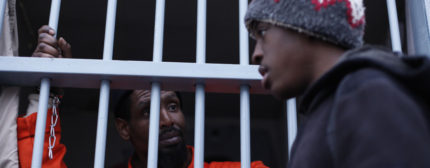
Because of the unique vulnerabilities of children, Juan Méndez, the United Nations special rapporteur on torture and other cruel, inhumane or degrading treatment or punishment, dedicated an entire report on their status in the world. To this end, Mendez singled out the United States in his 21-page report for its unusually cruel treatment of children.
“The unique vulnerability of children deprived of their liberty requires higher standards and broader safeguards for the prevention of torture and ill-treatment” Mendez, who is a law professor at American University. “Life sentences without the possibility of release for children are expressly prohibited by international law and treaties. The vast majority of States have taken note of the international human rights requirements regarding life imprisonment of children without the possibility of release. Significantly, the United States of America is the only State in the world that still sentences children to life imprisonment without the opportunity for parole for the crime of homicide.”
The U.S. being singled out is especially ironic, considering the nation’s penchant for traveling around the world and accusing other nations of human rights abuses—just this week charging Venezuelan officials with committing violence against anti-government protesters.
Various advocacy groups in the U.S. in recent years have released reports pushing states in the U.S. to end the practice, as more than 2,500 individuals currently serve a life sentence without possibility of parole for crimes they committed as children.
As revealed by the Sentencing Project in a report released in 2012, Black children are far more likely than any other children to receive life sentences. In fact, the proportion of Black children serving juvenile life sentences for the killing of a white person (43.4 percent) is nearly twice the rate at which Black juveniles are arrested for taking a white person’s life (23.2 percent).
By comparison, white juvenile offenders who killed a Black person are about half as likely (3.6 percent) to receive a life sentence as their proportion of arrests for killing a Black person (6.4 percent).
“Most of the sentences imposed on these children were mandatory: the court could not give any consideration to the child’s age or life history,” according to the Alabama-based Equal Justice Initiative, which successfully convinced the U.S. Supreme Court to halt the mandatory sentencing of children. “Some of the children were charged with crimes that do not involve homicide or even injury; many were convicted for offenses where older teens or adults were primarily responsible for the crime; 70 percent of condemned kids 14 or younger are children of color.”
At every step of their lives, Black children in the U.S. are disproportionately victimized by poverty, inadequate schools, insufficient mental health services, damaging neighborhoods and much higher rates of discipline, resulting in their engagement with the criminal justice system much more frequently than other children and at much younger ages. So it would stand to reason that when the confluence of these circumstances resulted in them committing murder, they would be punished much more harshly than other children—often in violation of international laws.
While 12 states and the District of Columbia have banned life sentences without the possibility of parole for juveniles, according to the Sentencing Project, two-thirds of the children who received that sentence were from just five states: Pennsylvania (472), Michigan (356), Florida (355), California (293), and Louisiana (228).
In addition, 73 children sentenced to life without parole were 13 or 14 years old at the time of their offense.
The Sentencing Project noted that many of these children experienced high rates of violence, abuse and economic disadvantage growing up.
“We know that this practice is also unfairly imposed upon our most vulnerable citizens — those who have already been failed by many of the systems that are supposed to protect them,” said Jody Kent Lavy, the director and national coordinator of the advocacy group the Campaign for the Fair Sentencing of Youth, according to Al Jazeera America. “In addition, there are significant racial disparities in the use of the sentence, with black youth sentenced to life without parole at a per capita rate 10 times that of white teens.”
Méndez, the United Nations special rapporteur, said in his report that any detention of children—including pretrial and post-trial incarceration as well as institutionalization and administrative immigration detention—can be considered ill-treatment because of their vulnerability.
“There is widespread agreement among experts that the institutionalization of children contributes to physical underdevelopment, abnormalities in brain development, reduced intellectual abilities and development, delays in speech and language development, and diminished social skills,” Mendez wrote in the report. “Inappropriate conditions of detention exacerbate the harmful effects of institutionalization on children. The Special Rapporteur observes that one of the most important sources of ill-treatment of children in those institutions is the lack of basic resources and proper government oversight.”
He stressed that children should always be charged, tried and sentenced within a nation’s system of juvenile justice, affording them adequate forms of protection, and never within the adult criminal justice systems.
“In addition, laws, policies and practices that allow children to be subjected to adult sentences are inherently cruel, inhuman or degrading because they fail to consider any of the special measures of protection or safeguards that international law requires for children,” he wrote. “Children should never be treated as if they were adults. Because children are less emotionally and psychologically developed, they are less culpable for their actions and their sentencing should reflect the principle of rehabilitation and reintegration.”
In the last decade, the U.S. Supreme Court has issued three rulings concerning the status of children defendants: In 2005’s Roper decision, the court ruled that juveniles cannot be sentenced to death for crimes committed when they were less than 18 years old. The ruling affected 72 juveniles in 12 states. Between 1976 and the Roper decision, 22 defendants were executed for crimes committed as juveniles.
In 2010’s Graham decision, the court banned the use of life without parole for juveniles not convicted of homicide. This ruling applied to at least 123 prisoners – 77 of whom had been sentenced in Florida.
In 2012’s Miller decision, the court held that mandatory life sentences without parole for juveniles violate the Eighth Amendment. Justice Elena Kagan wrote that adolescence is marked by “transient rashness, proclivity for risk, and inability to assess consequences,” which are all factors that judges should consider in mitigating the punishment received by juvenile defendants.
Mandatory life sentences “prevents taking into account the family and home environment that surrounds him — and from which he cannot usually extricate himself — no matter how brutal or dysfunctional,” Justice Kagan wrote.
Both the Graham and Miller decisions were argued before the court by the Equal Justice Initiative.
But despite these court decision, states have been mixed in deciding what to do with the 2,500 individuals currently serving life sentences for crimes they committed as children. Some state Supreme Courts (Illinois, Iowa, Massachusetts, Mississippi, Nebraska, and Texas) have ruled that Miller applies retroactively, while other states (Louisiana, Minnesota and Pennsylvania) have ruled that Miller is not retroactive, according to the Sentencing Project. Cases are still pending in Florida and Washington.
“The big issue is whether that decision from the Supreme Court has a retroactive effect so that persons who are serving life in prison without parole can benefit from that,” said Steven Watts, the senior staff attorney at the American Civil Liberties Union human rights program. “In the 1990s, [courts] increased the numbers of offenses for which children could be sentenced as if they were adults. They were charged, prosecuted — as young as 14 — charged, prosecuted, convicted and sentenced as if they were adults. That comes from a debunked theory from back in the 1990s that there are these superpredators, incorrigible children, that it was built into their DNA that they would do the wrong things.”
“We’re still living with those laws, enacted at that time, and it happens to a degree in the U.S. that doesn’t happen anywhere else in the world,” he added.
In response to the UN report, Dr. Louis Kraus, the chairman of the juvenile justice reform committee at the American Academy of Child and Adolescent Psychiatry, said the practice of issuing life sentences was “a devastating process to even conceptualize.”
“These kids have not developed. These are eighth-graders and, in some states, younger than that,” he told Al Jazeera America. “The toughest part is that the crimes children might have committed, as devastating as they may have been, are really in unformed brains. These teenagers are not the same as their adult counterparts will be. Many of them are not going to be that same person. They’re going to show greater insight, better empathy, less impulsivity, better reasoning ability in terms of understanding the short- and long-term ramifications of their behavior.”

